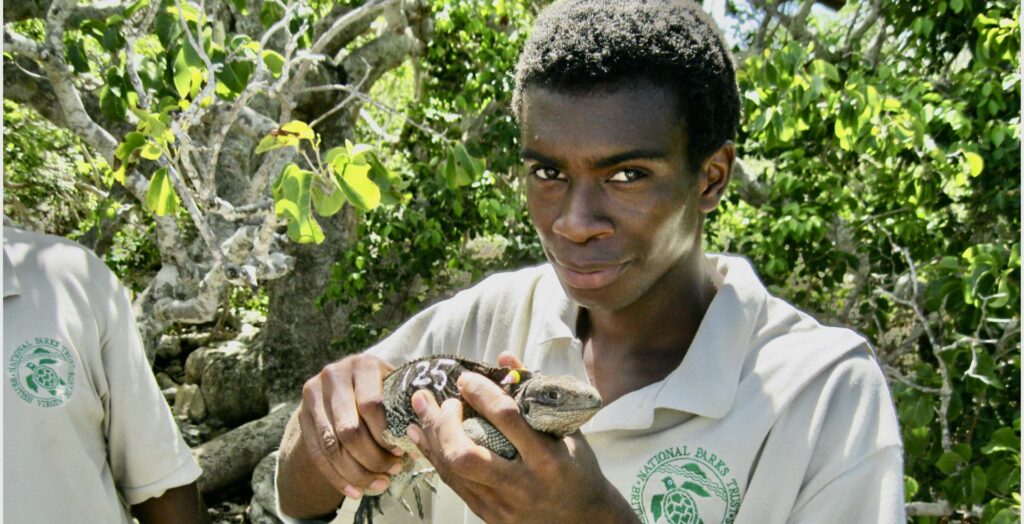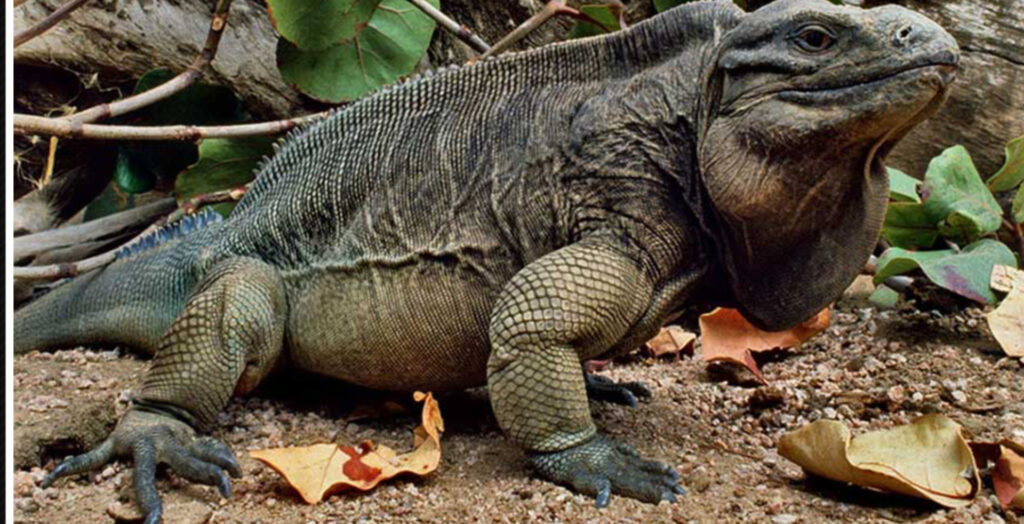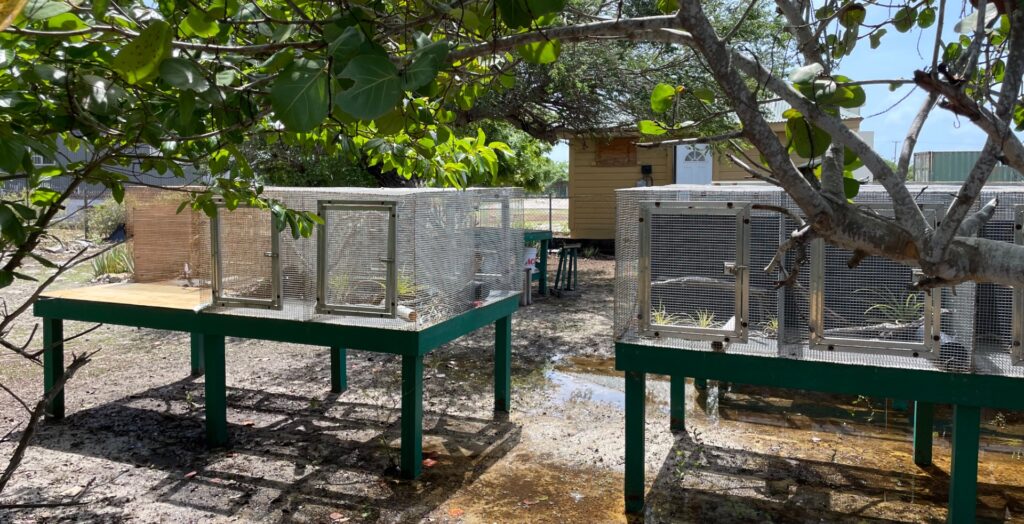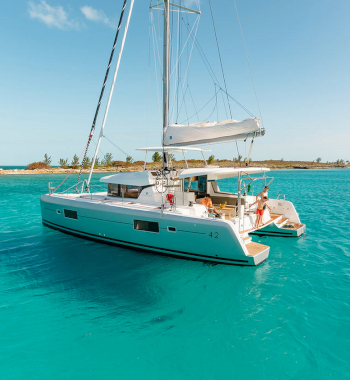The Anegada Rock Iguana is Making a Comeback
A joint conservation effort by the Virgin Islands National Parks Trust and the Fort Worth Zoo aims to protect this highly endangered species.
By Claudia Colli
They look like a relic from the prehistoric past. Close to two-feet long with a chunky body, bowed legs, and a spiky dorsal crest which fans from the top of the male’s head like an elaborate headdress, the Anegada Rock Iguana may not win a beauty contest, but its charms are many.

Endemic to the BVI, and specifically to Anegada, the Rock Iguana is one of the BVI’s most well-known residents – and one of the world’s endangered species. Vulnerable to habitat loss, and predation by cats, the iguanas have been on the decline for decades. Perhaps 90% of iguanas are victims of feline predation.
“The Cyclura pinguis is one of the oldest of the rock iguanas of the Caribbean,” explained Nancy Woodfield Pascoe, the Virgin Islands National Parks Trust Deputy Director. “It is the one on the top, so all the others are descendants of it.” There are 50 species of iguanas in the world and 16 are found in the Caribbean; the Anegada Rock Iguana is one of the most fascinating.
Protecting these creatures, and ensuring that they are brought back from the edge of extinction, is the mission of the Virgin Islands National Parks Trust and a group of conservation organizations including the IUCN (International Union for the Conservation of Nature) and the Fort Worth and San Diego Zoos.
These unlikely partnerships between organizations located thousands of miles apart got a significant boost in 1994 when the Fort Worth Zoo, under the stewardship of Michael Fouraker, the facility’s Executive Director, partnered with the Trust to build the Head Start facility in Anegada’s Settlement.

Michael Fouraker explained that the zoo has been involved in iguana research throughout the Caribbean. In 1993, along with biologist Rick Hudson, he attended a meeting of iguana experts in Jamaica, and a year later came to the BVI. The first Head Start facility was built shortly after – a single wooden cage built by Michael. “That was my design and it stood through five hurricanes,” he said.
The program’s aim is simple. Trained staff, with the help of alert residents, search for iguana nests. When the eggs hatch, a portion of the hatchlings are transferred to the Head Start facility where they are fed and nurtured until large enough to be released back into the wild. The facility’s enclosures are strong and durable withstanding even Hurricane Irma in 2017. The zoo also supplies much needed equipment like food processors for chopping food; lettuce being an iguana favorite. A visitor center at the Head Start facility was funded by a grant from the European Union.
The 100-year-old Fort Worth zoo has a well-respected ectotherm program. These cold blooded animals include fish, snakes, insects and lizards including iguanas. Their expertise has been instrumental in reversing the Rock Iguana’s decline. Kelly Bradley, a biologist at the Fort Worth Zoo was among the experts instrumental in protection efforts and ongoing research on the Anegada Rock Iguana. Commuting from Texas to Anegada several times a year, she searched for nests, helped gather the new hatchlings and transferred them to the Head Start facility. Once released she tracked their movements to determine their survivability rate.
Another organization with an interest in the Anegada Rock Iguana is Kew Gardens. Through its Darwin Project, the renowned UK based botanical garden and research facility studies VI forest health and resilience in partnership with the National Parks Trust here.

“We are looking at varying interactions between plants and different species,” noted Nancy Pascoe. The Anegada Rock Iguana, for instance, is an important seed disperser.
Community education is a large component of the program to preserve and propagate Anegada’s iguana population. “We educate the community on how important they are. They are now growing as a tourism attraction in Anegada which is helping to increase the island’s economy as well,” explained Nancy.
Another educational tool is a film by Madeline Westwood, a student at the UK Film and Television School. The 10-minute film is narrated by an Anegada school student, and highlights island efforts to conserve this endangered creature. The filmmaker has entered the short in an international film competition which was screened in the VI at the end of 2020.
The community outreach is working in a variety of unexpected ways. “After Hurricane Irma, Anegada residents, who evacuated to Tortola, would call us and say: ‘We are on Tortola, can we take food back for the iguanas?’” recalled Michael Fouraker.
In addition to efforts to foster the rock iguana’s survival in its native Anegada habitat, small populations of the threatened species have been transported by the owners of Guana Island and Necker Island, where they are being bred and their populations are thriving. Experts from the San Diego Zoo, through its Institute for Conservation Research, monitored these efforts. They have been looking at the population genetics of these introduced populations and are investigating options for making them more genetically robust. Among the options being explored with the VI NPT is introducing an iguana population to a protected area on public land on another island.
At one time, the range of the Anegada Rock Iguana might have been more widespread. In millennia past, Puerto Rico and the Virgin Islands were joined in a single land mass, and it is possible that the iguanas might have been found throughout the area known as the Puerto Rican Bank. Iguana bones have been found on other islands in the BVI, but could have been transported there for food., explained Nancy Pascoe who also stated that the animals are proficient swimmers. “A few rogue iguanas have been found on other islands, including one that turned up on Cooper Island after Hurricane Irma,” she said.
At the annual Anegada Iguana Fest, iguana hatchlings are released after reaching a level of maturity that will allow them to survive in the wild. As of 2022 the Fort Worth Zoo stated that the program expected to release its 300th iguana. A proud moment for the zoo and the VI National Parks Trust custodians.
The gradual comeback of the Anegada iguana is certainly something to celebrate, but nonetheless, we cannot let our guard down yet. The population is still fragile and requires all in the BVI to take an interest in this exceptional creature.
Concluded Nancy, “everyone in the BVI should be proud of the iguana because it belongs to the British Virgin Islands. It is truly a unique species. It is very important in terms of biodiversity. Not only is it very rare, this is the only place in the world it is found.”
For more about Anegada Rock iguana conservation efforts by the Fort Worth Zoo and the VI National Parks Trust go to:
https://www.fortworthzoo.org/conservation-blog/posts/anegada-iguana
Read about VI National Parks Trust conservation efforts with Kew Gardens at:






